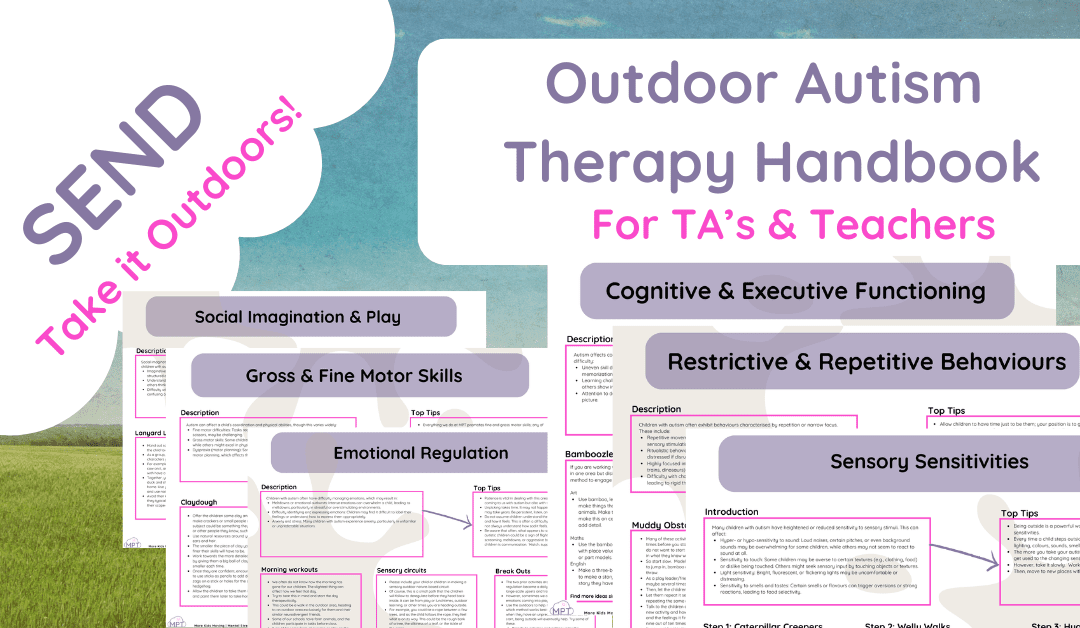Introducing the Outdoor Autism Therapy Handbook: A Natural Approach to Autism Support
In recent years, educators and therapists have increasingly recognized the value of outdoor environments in supporting children with autism. From sensory integration to social development, nature offers a unique, calming space for children to thrive. To support professionals and parents, we are thrilled to introduce the Outdoor Autism Therapy Handbook, a resource designed to blend autism therapy with outdoor learning approaches inspired by the well-known Muddy Puddle Teacher (MPT) Approach.
In this blog post, we’ll explore how this handbook can be a game-changer for anyone working with children on the autism spectrum and highlight the benefits of nature-based interventions for autism therapy.
Why Outdoor Learning Benefits Children with Autism
Outdoor learning has numerous advantages for children with autism, particularly those who exhibit sensory sensitivities, repetitive behaviours, or social challenges. The outdoor environment offers:
- Sensory Regulation: Nature provides a variety of sensory stimuli—like the feeling of grass, the sound of birds, or the smell of flowers—helping children engage their senses in a calm, controlled way.
- Physical Activity: Outdoor play helps autistic children develop gross motor skills and provides a healthy outlet for energy.
- Emotional Regulation: The calming effects of being in nature can help reduce anxiety, frustration, and stress, supporting better emotional regulation.
If you’re curious about how outdoor learning impacts children, check out the benefits of outdoor learning from the Muddy Puddle Teacher approach.
What Is the Outdoor Autism Therapy Handbook?
The Outdoor Autism Therapy Handbook provides educators, therapists, and parents with a practical guide to incorporating outdoor learning and therapeutic activities into their daily routines with children on the autism spectrum. This resource is grounded in the principles of the Muddy Puddle Teacher (MPT) approach, which emphasizes child-led, nature-based learning.
The handbook includes:
- Practical Outdoor Activities: Ideas for hands-on outdoor learning experiences that encourage sensory play, social interaction, and physical movement—all tailored to the specific needs of children with autism.
- Therapeutic Strategies: Step-by-step guidance on how to adapt outdoor activities to meet therapeutic goals, such as improving communication, reducing anxiety, and managing restrictive behaviours.
- Tools for Parents and Educators: Resources and strategies for integrating outdoor learning into autism support plans, ensuring that children are actively engaged in their development and non-pressured.
How the Muddy Puddle Teacher Approach Supports Children with Autism
The Muddy Puddle Teacher Approach has long been celebrated for its child-centred, sensory-rich outdoor learning philosophy. When working with children on the autism spectrum, this approach offers several advantages:
- Child-Led Exploration: The MPT approach encourages children to take the lead in their learning, allowing them to explore the outdoor environment in comfortable ways. For children with autism, this independence can foster confidence and self-regulation.
- Natural Sensory Engagement: Outdoor learning incorporates natural materials and textures, such as mud, water, and sand, providing children with safe and structured sensory experiences. These activities can help children on the spectrum process sensory information more effectively. Learn more about sensory benefits in nature in the Outdoor Learning and Autism guide by MPT.
- Emphasis on Routine with Flexibility: While routines are important for children with autism, the MPT approach allows for flexible routines in outdoor settings, helping children become more comfortable with transitions and small changes.
For more insight into how the MPT approach can be tailored to meet the needs of children with autism, visit Muddy Puddle Teacher Autism Resources.
Sample Activities from the Outdoor Autism Therapy Handbook
Here’s a sneak peek into some activities you can expect to find in the Outdoor Autism Therapy Handbook:
1. Nature Sensory Walk
- Objective: Help children engage with their senses while exploring their environment.
- How It Works: Take the child on a walk through a park or woodland and ask them to collect different textures—such as smooth stones, rough bark, and soft leaves. The repetitive motions of gathering and sorting can be comforting for children with autism while also encouraging sensory exploration.
2. Bubble Play
- Objective: Promote repetitive, calming actions while encouraging social interaction.
- How It Works: Use bubbles to engage the child in repetitive popping movements, solo or with peers. This activity can help children with autism focus on their breathing and motor skills, while also providing a sensory-rich experience in an outdoor setting.
For more outdoor activities designed for children with special educational needs, check out the Outdoor Learning Activities for Children with Autism page.
How to Use the Handbook in Schools and at Home
The Outdoor Autism Therapy Handbook is designed to be flexible and adaptable for school and home settings. Educators can integrate the activities into their existing outdoor learning programs, while parents can use the handbook to support their child’s therapy at home or in local parks.
For teachers and school leaders looking to embed outdoor learning into their curriculum, the Muddy Puddle Teacher Training offers courses and certifications to guide you through the process of creating a successful outdoor learning environment for all children, including those with special needs.
Why You Should Try the Outdoor Autism Therapy Handbook
If you’re looking to support a child with autism in an outdoor setting, the Outdoor Autism Therapy Handbook offers a wealth of resources to help you get started. Grounded in the highly effective Muddy Puddle Teacher Approach, this handbook provides the tools you need to create a structured, engaging, and therapeutic outdoor learning environment.
The benefits of outdoor learning for children with autism are profound—from improving sensory processing to fostering independence and reducing anxiety. Start incorporating nature into your therapy or educational plan today, and watch its positive impact on the children in your care.
Explore More
For more ideas on how to support children with autism using the Muddy Puddle Teacher approach, check out these resources:


